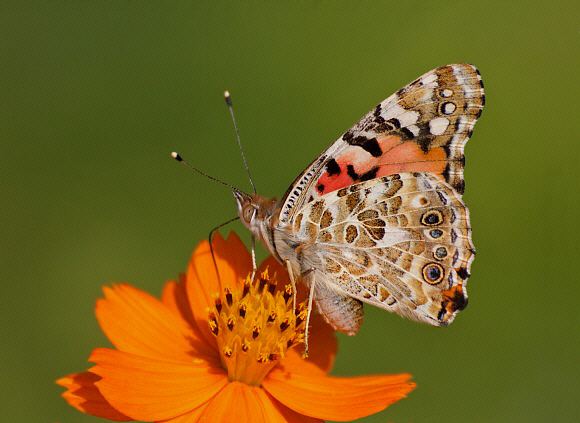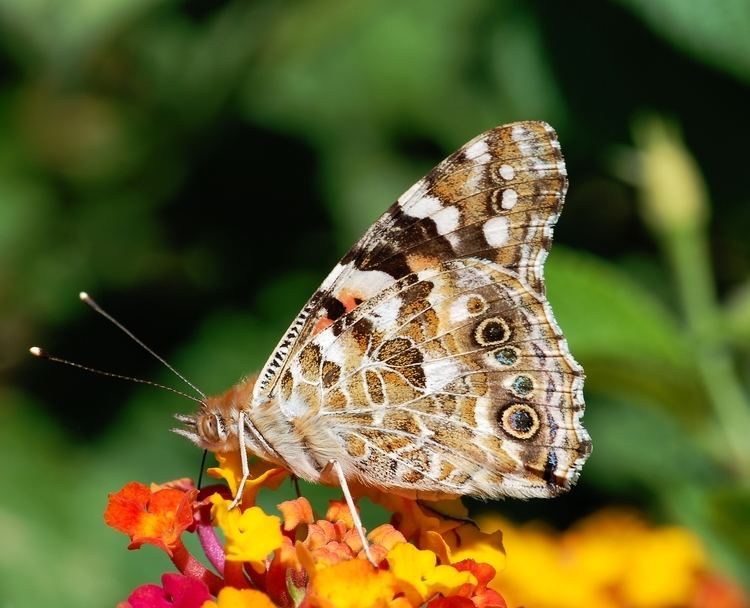Scientific name Vanessa cardui Wingspan 5 cm (Adult) Rank Species | Subgenus Cynthia Lifespan 12 months (In the wild) Higher classification Painted lady | |
 | ||
Similar Painted lady, Butterflies and moths, Vanessa atalanta, Butterfly, Small tortoiseshell | ||
Painted lady nymphalidae vanessa cardui in grass
Vanessa cardui is a well-known colorful butterfly, known as the painted lady, or in North America as the cosmopolitan. This butterfly has a strange pattern of flying in a sort of screw shape.
Contents
- Painted lady nymphalidae vanessa cardui in grass
- Vanessa cardui
- Distribution
- Migration
- Mating behavior in relation to migration
- Oviposition
- Roosting behavior and territory
- Host plants
- Defense mechanisms
- Human interaction
- References

Vanessa cardui
Distribution
V. cardui is one of the most widespread of all butterflies, found on every continent except Antarctica and South America. In Australia, V. cardui has a limited range around Bunbury, Fremantle, and Rottnest Island. However, its close relative, the Australian painted lady (V. kershawi, sometimes considered a subspecies) ranges over half the continent. Other closely related species are the American painted lady (V. virginiensis) and the West Coast lady (V. annabella).
Migration

V. cardui occurs in any temperate zone, including mountains in the tropics. The species is resident only in warmer areas, but migrates in spring, and sometimes again in autumn. It migrates from North Africa and the Mediterranean to Britain in May and June, but for decades, naturalists have debated whether the offspring of these immigrants ever make a southwards return migration. Research suggests that British painted ladies do undertake an autumn migration, making a 9,000-mile (14,000 km) round trip from tropical Africa to the Arctic Circle in a series of steps by up to six successive generations. The Radar Entomology Unit at Rothamsted Research provided evidence that autumn migrations take place at high altitude, which explains why these migrations are seldom witnessed.

V. cardui is known for its distinct migratory behavior. In California, they are usually seen flying from north to northwest. These migrations appear to be partially initiated by heavy winter rains in the desert where rainfall controls the growth of larval food plants. Painted lady migration patterns are highly erratic and they do not migrate every year. Some evidence suggests that global climatic events, such as el Niño, may affect the migratory behavior of the painted lady butterflies, causing large-scale migrations.
Based on experimental data, the painted lady's migration pattern in northern Europe apparently does not follow a strict northwest heading. The range of headings suggests that migrating butterflies may adjust their migration patterns in response to local topographical features and weather, such as strong wind patterns. Laboratory-raised autumn-generation painted lady butterflies were able to distinguish a southern orientation for a return migration path. According to the same laboratory-based study, when butterflies were isolated from the sun, they were unable to orient themselves in a specific direction, opposed to those that did have access to the sun. This suggests that V. cardui requires a direct view of the sky, implying the use of a solar compass to orient its migratory direction and maintain a straight flight path.
Mating behavior in relation to migration
V. cardui displays a unique system of continuous mating, throughout all seasons, including the winter. This may be attributed to its migratory patterns, thus significantly affecting its mating behavior. During European migrations, the butterflies immediately begin to mate and lay eggs upon arrival in the Mediterranean in the spring, starting in late May. In the United States, painted lady butterflies migrating towards the north experience poor mating conditions, and many butterflies have limited breeding capabilities. The "local adult generation" develops during this time, roughly from the middle of May through early June in conjunction with the butterfly progression throughout their flight.
During its migratory process, these painted lady butterflies start breeding, and reproduce entirely throughout their migration. Scientists have not been able to find evidence of their overwintering; this may be because they migrate to warmer locations to survive and reproduce. Female painted lady butterflies may suspend their flight temporarily when they are "ready to oviposit"; this allows them the opportunity to continually reproduce throughout their migrations. Because these butterflies are constantly migrating, male butterflies are thought to lack consistent territory. Instead of requiring territory to mate with females and developing evolutionary behavior to defend this territory, the mating butterflies appear to establish a particular "time and place" in certain locations that they find to be suitable for reproduction. More specifically, they locate certain perches, hilltops, forest-meadow edges, or other landmarks where they will stay until, presumably, a female to mate.
Equally important for the reproduction of the painted lady butterflies is the males' exhibition of polygynous mating behavior, in which they often mate with more than one female. This is important for painted lady butterflies because the benefits may supersede the costs of polygyny since no permanent breeding ground is used. Upon mating, which typically occurs in the afternoon, female painted lady butterflies lay eggs one by one in their desired breeding locations. The variety of eclosion locations ultimately dictates the male painted lady behavior.
Female painted lady butterflies have been observed to have a relatively "high biotic potential", meaning they each produce large numbers of offspring. This perpetual influx of reproduction may be a reason why these painted lady butterflies have propagated so successfully. One interesting aspect that scientists have observed is that these butterflies like to fly towards rain. Further studies have suggested that the large amounts of rainfall may somehow "activate more eggs or induce better larval development". Inhabited locations begin to observe a large influx of new generations of painted lady butterflies in the fall, particularly in September and October. Their reproductive success declines relatively throughout the winter, primarily through November. However, they still continue to reproduce—an aspect of butterfly behavior that is quite unique. Scientists hypothesize that these extensive migratory patterns help the painted lady butterflies find suitable conditions for breeding, thus offering a possible reason as to why these butterflies mate continuously.
Oviposition
Adult butterflies feed on flower nectar and aphid honeydew. Females oviposit on plants with nectar immediately available for the adults even if it leads to high mortality of the larvae. This lack of discrimination indicates they do not take into account volatile chemicals released from potential host plants when searching for oviposition choices.
The availability of adult resources dictates preference for specific areas of flowers. Flowers with more available nectar result in a larger number of eggs deposited on the plants. This reinforces the idea that the painted lady butterfly does not discriminate host plants and chooses mainly on availability of adult food sources even if it increases mortality rate of the offspring. The data also suggest that the painted lady butterfly favors quantity of offspring over quality.
Roosting behavior and territory
Groups of two to eight painted lady butterflies have been observed to fly in circles around each other for about one to five seconds before separating, symbolizing courtship. Groups of butterflies usually will not fly more than 4.5 m away from the starting point. To establish and defend their territories, adult males perch in the late afternoon in areas where females are most likely to appear. Once the male spots a female of the same species, he begins pursuit of her. If the foreign butterfly is a male, the original male will give chase, flying vertically for a few feet before returning to his perch.
V. cardui establishes territories within areas sheltered by hedgerows. Vanessa cardui tend to inhabit sunny, brightly lit, open environments and are often attracted to open areas of flowers and clovers. Adults spend time in small depressions in the ground on overcast days.
Host plants
Larvae feed on Asteraceae species, including Cirsium, Carduus,Centaurea, Arctium, Helianthus, and Artemisia.
The painted lady uses over 300 recorded host plants according to the HOSTS database.
Defense mechanisms
The main defense mechanisms of the painted lady butterflies include flight and camouflage. The caterpillars hide in small silk nests on top of leaves from main predators that include wasps, spiders, ants, and birds.
Human interaction
Vanessa cardui and other painted lady butterflies are bred in schools for educational purposes and used for butterfly releases at hospices, memorial events and weddings.
